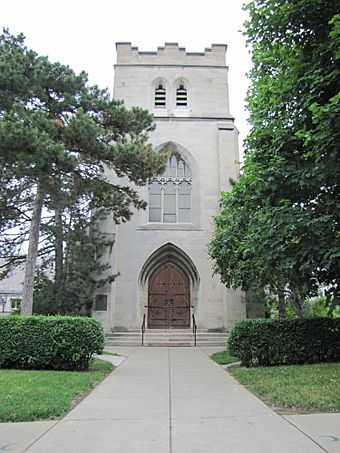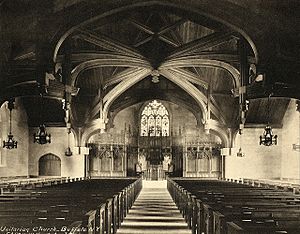Unitarian Universalist Church of Buffalo facts for kids
Quick facts for kids |
|
|
First Unitarian Church of Buffalo
|
|
|
U.S. Historic district
Contributing property |
|

Unitarian Universalist Church of Buffalo, June 2011
|
|
| Location | 695 Elmwood Avenue, Buffalo, New York |
|---|---|
| Area | .53 acres (0.21 ha) |
| Built | 1904-1906 |
| Architect | Edward Austin Kent |
| Architectural style | English Gothic |
| NRHP reference No. | 15000367 |
| Added to NRHP | June 30, 2015 |
The Unitarian Universalist Church of Buffalo is a historic church building in Buffalo, New York. You can find it at 695 Elmwood Avenue. A famous architect named Edward Austin Kent designed the building in 1906. Sadly, Kent passed away in 1912 on the RMS Titanic. There is a special plaque inside the church that honors him.
This church is part of the Unitarian Universalist Association today. It was first known as the First Unitarian Church of Buffalo. Later, in 1953, another church called the Universalist Church of the Messiah joined them. Both groups started in 1831. They began worshiping together as the Unitarian Universalist Church of Buffalo. The two types of churches, Unitarian and Universalist, officially joined together across the country in 1961.
Contents
The Church Building's Design and History
The church building was finished in 1906. The land for the church was given by John J. Albright. He also helped build the Albright–Knox Art Gallery in Buffalo. In 1908, a man named Col. Charles Clifton paid off the rest of the church's building loan. He did this so that people would never have to pay to sit in the pews.
The church is built in a style called Gothic Revival. This means it looks like old European churches. The walls and window frames are made of Indiana limestone. It has a cool, castle-like top edge called a crenelated turret. The big oak doors have fancy wrought-iron decorations shaped like fleur-de-lis.
Inside, the church looks like an English Country Gothic building. The main worship area can seat 400 people. It has a huge oak hammer beam ceiling that reaches high above the floor. The walls and floor inside are also made of the same light-colored Indiana limestone. This simple stone helps the beautiful oak and glass parts stand out.
The beautiful Art Nouveau stained glass windows were made by Harry E. Goodhue from Boston. He also designed windows for other churches. The large pipe organ in the choir area was built in 1906 by the Hutchings-Votey Organ Company. This company also built other famous organs, like one at Yale University. The organ was updated in 1960 by the Delaware Organ Company.
The church was added to the National Register of Historic Places on June 30, 2015. It is recognized as the First Unitarian Church of Buffalo. It is also part of the Elmwood Historic District–East.
McCann Memorial Library
The McCann Memorial Library is inside the church. It has about 2,700 books. These books cover many different topics. You can find books about Unitarian Universalism, other world religions, and philosophy. There are also books about important life topics like death and divorce. The library has books on environmentalism, religious education, and inspiring fiction and poetry. For kids and teens, there are books to help with life issues. There are also many fun books just for reading.
Unitarian Universalist Principles
Unitarian Universalist churches follow seven main principles. These are like guiding ideas for how they live and act:
- Every person is important and has worth.
- We should be fair, equal, and kind to everyone.
- We should accept each other and help everyone grow spiritually.
- People should be free to search for truth and meaning in life.
- Everyone has the right to their own beliefs. We should use fair, democratic ways in our churches and in society.
- We should work for a peaceful world where everyone has freedom and justice.
- We should respect all living things and the planet, because we are all connected.
See Also
- Unitarianism
- Universalism
- Unitarian Universalism
- Edward Austin Kent
- John J. Albright





